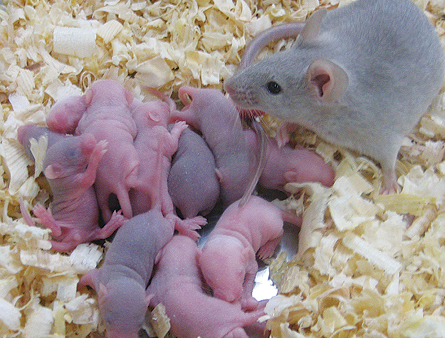- More than 2 years ago
Some baby mice born in Japan are living proof that mouse stem cells taken from embryos or created by reprogramming fetal tissue can be used to make viable egg cells.

Researchers had already created functional sperm from stem cells, and some groups have reported making eggs, or oocytes, but those had never been shown to produce offspring. Now, Mitinori Saitou of Kyoto University in Japan and colleagues have coaxed mouse stem cell to make eggs that produce normal, fertile offspring, the researchers report online October 4 in Science.
“This is really pioneering research,” says Charles Easley, a reproductive stem cell biologist at Emory University School of Medicine in Atlanta.
The researchers have gone a step beyond making cells that merely look like eggs in a lab dish. “This paper produces something that looks like oocytes, smells like oocytes and tastes like oocytes in a way no one has done before,” says David Albertini, a reproductive scientist at the University of Kansas Medical Center in Kansas City.
While the evidence that the Japanese researchers have transformed mouse stem cells into functional female gametes is compelling, Albertini doesn’t think the feat will be repeated with human stem cells because they are far less flexible than their mouse counterparts. The new technology might provide a way to test the effect that chemicals in the environment may have on fertility and give scientists new information about how eggs age, possibly leading to fertility-extending treatments, he says.
In the new study, Saitou and colleagues started with stem cells from very early mouse embryos as well as stem cells reprogrammed from fetal cells, known as induced pluripotent stem cells. Saitou’s team manipulated the activity of a few genes in the stem cells to turn them into cells that resemble precursors of gametes, as eggs and sperm are sometimes known.
These primordial germ cell–like cells, as they are called, were mixed with support cells from an embryonic ovary and then transplanted into adult mice. Once the precursor cells had developed into oocytes, the researchers pulled them out and fertilized them in the lab before implanting the resulting embryos in female mice.
The oocytes made from embryonic stem cells produced mouse pups 3.9 percent of the time. Oocytes from reprogrammed stem cells did better, resulting in pups 8.6 percent of the time. Those rates are lower than for primordial germ cells taken directly from mouse embryos, which the researchers found produced pups 17.3 percent of the time. Oocytes taken from the ovaries of 3-week-old mice generated offspring 12.7 percent of the time. Female pups resulting from stem cell–derived eggs grew up to become fertile adults, the researchers report.
About half of the stem–cell derived oocytes had an extra set of chromosomes, the researchers discovered. That indicates a breakdown in meiosis, the process of halving the genetic material doled out to eggs and sperm. Saitou acknowledges there is room for improvement in his group’s technique.
Previous experiments have tried to produce oocytes in a laboratory dish. The Japanese group’s success argues that other cells in the ovary probably help guide primordial cells to become mature eggs. “It’s not like oocytes just spring up out of nowhere,” says Easley. “They’ve got support cells all around them.” Scientists will need to figure out what the support cells do to help developing oocytes reach their full potential to mimic the process in the lab.
It may not be practical to use the same technique to try to generate human oocytes: The support cells used in the study were isolated from embryonic mouse ovaries at a stage equivalent to that of 10- to 14-week old human fetuses.
“If it is dependent on fetal ovaries, that makes it completely impractical for human use,” says Jonathan Tilly, a reproductive biologist at Massachusetts General Hospital and Harvard Medical School in Boston. The method also requires surgery to put the reconstituted ovary into a body to mature, and more surgery to retrieve the eggs — another possible barrier for use in people.
Editor’s Note: This story was corrected on 10/17/12.






